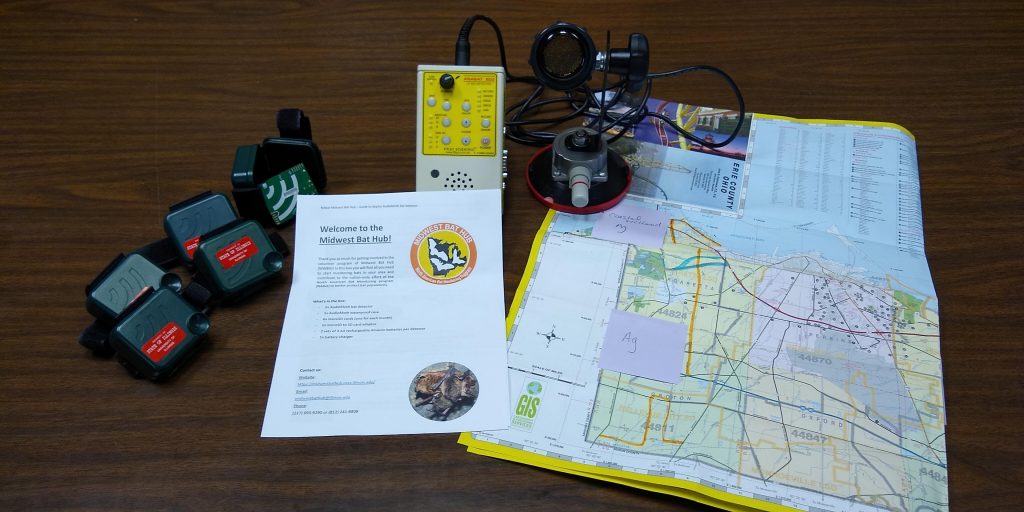The Erie Soil and Water Conservation District has supported wildlife conservation as one of the targets for natural resource management. This year, the District is diving into the world of bats with a new pilot study that will focus on understanding the relationship between stream health and bat presence within the Sandusky region and Erie County.
The state of Ohio has 10 bat species that are all insectivores and split into two groups: cave-dwelling bats and tree-dwelling bats. Cave-dwelling bats often form colonies and may congregate in caves or vegetation depending on the time of year. On the other hand, tree-dwelling bats are solitary and migrate to warmer locations in the winter. All species are considered keystone species, meaning they
One individual bat can consume up to 1,000 or more insect species within an hour, many of which are harmful to agriculture production and human health. The USGS suggest that the economic value of bats can save $3.7 billion annually in crop damage and pesticide use.
The Ohio Working Bat Group has identified three resources that bats need for their survival: water sources for drinking, vegetation (dead and living) for roosting, and numerous insects for eating. During the spring and summer period, bats often use vegetation for roosting and to raise their young. Living and dead trees are often used as the bark, cavities, and foliage can provide cover during the day as they sleep. By night, they emerge and begin to hunt. For female bats raising young, vegetation and clean water is important. The young stay within the roost while the mothers forage at night. Mother bats also need plenty of water as it helps with lactation. In fall, hibernating bats will gorge on insects until they build fat reserves that will support them while they slumber throughout the winter.
Unfortunately, bats are on a decline due to a combination of white-nose syndrome, habitat loss, and habitat degradation. In 2006, the state of New York found bats with a noticeably white fuzz around their muzzle and later discovered cave floors covered with dead bats. The fuzz growing on the bats was identified as a fungus, hence white-nose, and is known to grow within cool and humid environments. White-nose infected bats will also have fungus on growing on their wings, ears, and skin, which causes an intense itching sensation. Because of this, bats woken from their hibernation may not be able to fall back asleep and risk using up their fat reserves – leading to starvation and dehydration. Due to the severity of the disease, hibernating bat species such as little brown bats, northern-long eared bats, and tri-colored bats, experienced a 90% population decline.
Meanwhile, the expansion of urban and agriculture development continues to fragment, destroy, and/or degrade habitats, creating limiting resources and potentially dangerous situations for many wildlife species. Bats are equally susceptible to these issues and are known to have site fidelity, meaning they return to their roost annually. If these roosts are removed, it can be energetically costly. In addition, increase light, noise, and water pollution may also negatively affect bats.
The District is interested to see if the streams/watersheds within the Sandusky region that experience constant landscape changes can potentially support bat populations. Based on the Ohio Working Bat Group’s suggestion, watershed habitats can supply bats the resources they need to survive, but if these systems are changing, only some bat species may be able to adapt. Between Pipe Creek, Mills Creek, and Old Woman Creek water quality and macroinvertebrate data, the District will be able to compare this information with bat presence. To collect data, the District is collaborating with the Ohio Department of Natural Resources and the Midwest Bat Hub, a research team located in Illinois, who have offered to loan both mobile and stationary detectors. These detectors are designed to pick up noise frequencies that are not audible to the human ear.
The detectors contain SD cards that are able to record and store neighboring bat calls. The District has permission by Perkins Township, Erie Metroparks, and one private landowner to install five stationary detectors. Once installed, staff or volunteers will have to travel to these sites to swap out the SD cards and ensure the stationary detectors are working. Meanwhile, the mobile detector has a microphone that is secured to the roof of a vehicle. The surveyor then drives around designated routes at 20 mph, which gives enough time to pick up any bats passing over.
Staff are currently performing mobile surveys until the end of May to capture when bats are emerging from hibernation or returning from migration. The stationary detectors will be installed sometime in April and will be active until the beginning of August. Watershed and bat presence data sets will be compared to evaluate how bats are doing within Erie County. Keep a look out for continued updates on the project!

